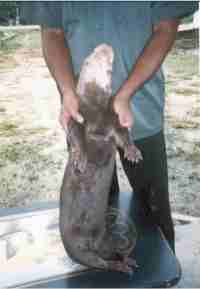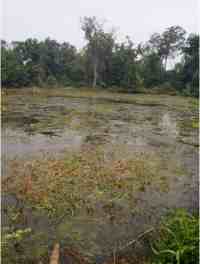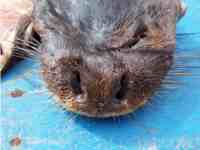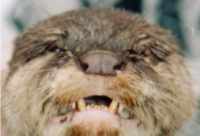 |
Last Update:
Thursday November 22, 2018
|
| [Home] |
|
Volume 22 Issue 1 Pages 1 - 44 (April 2005) Citation: Lubis, R. (2005) First Recent Record of Hairy-Nosed Otter in Sumatra, Indonesia. IUCN Otter Spec. Group Bull. 22(1): 14 - 20 First Recent Record of Hairy-Nosed Otter in Sumatra, Indonesia Reza Lubis Wetlands International – Indonesia Programme, Jl. Ahmad Yani no 53 Bogor, Indonesia. e-mail: relub@indo.net.id
On January 12th, 2005, I made a road trip with our driver from the main city Palembang to Sekayu, that both are located in Southern Sumatra, Indonesia. This was just another regular visit that I make once in every two weeks to have discussions on peat-swamp conservation with the Sekayu officials. I never though that particular morning will be an amazing experience in rediscovering a very elusive otter species, the hairy-nosed otter! Our car passed along a straight smooth asphalt road, by the side of Musi River, surrounded by flooded swamp and shrub forest. We drove about 60 km/h and my eyes were wide opened on the road far ahead. This was not only to pay attention to opposite cars passing by, but also what was lying on the asphalt road. Suddenly I spotted a black carcass about 300 meters in front of us and I thought it may be just another dead palm-civet or one of the abundant macaques. Nevertheless, I told the driver to slow down, just to identify the carcass. The road had fortunately less traffic during that morning. As we stopped near the dead animal, I saw that it has a slender long body, long snout and webbed feet and I knew that it was a dead otter! Without further delay, I told the driver to pull the car off to the side of the road. My hands were shaking looking for the camera in my rucksack, but it was not there as I had left it at home to recharge the batteries. So, unfortunately there was no camera for me at the time. So I decided to take the body to Sekayu and look for a camera there. I rushed to the body and checked whether it was still breathing. Unfortunately there was no sign of life. No blood shed either. Then I started with the standard protocol on identifying the otter species. I checked for the absence of claws first, as if it was clawed, I thought this might be the common Amblonyx cinerea. No claws though, so it must be non-Amblonyx. But the body size is too small for the rather common Lutrogale perspicillata. Could this be the rare Lutra lutra or even the elusive Lutra sumatrana? My heart was beating very fast, as I slowly lifted its head to look for the rhinarium area. My heart almost stopped at that time, as I discovered that the rhinarium area was covered with hairs! I screamed out of excitement, this was the time when our driver started to get more confused about what I was doing. I told him that we may have discovered a very rare otter species. It was the Hairy-Nosed Otter (Lutra sumatrana). An otter species that was known to occur only in South East Asia, distributed from Thailand to Indonesia. Before this finding, its existence in Indonesia was in doubt as the last record of this species came around 1960’s and it was not clear whether it was Lutra sumatrana or just another misidentification.
I could feel that the body was still warm and soft, meaning that it had just been killed about several minutes ago. No blood or injury was seen in its body. However, I could see that its vertebrae were twisted and its right hind foot was broken. I also felt a strange globular shaped structure under its skin on the dorsal side of his neck. Could this be the magical stone that an otter own that most of the local people speak of when we discuss about the species? I looked around the surroundings for anyone who might have witnessed the accident. But nobody was present. The surrounding area was a flooded open swamp with shrubs, oil palm and rubber plantations. The Musi River flows parallel to the road. There was a small tributary that crosses the road about 50 meters in front of us. My guess is that this otter may have been on its way from the big flooded Musi River to the open swamp, searching for dry ground, and got killed when crossing the road. My next question is why did he cross the road on the ground and not used the tributary? This may have been due to the high water level that was there in the tributary in that morning. We were already late for a meeting with Sekayu official, so it was not possible to do a thorough survey of the habitat. Without a camera and GPS, I was more than helpless. So I decided to come back later with proper equipment and preparation. We took the dead otter and drove to Sekayu. In Sekayu, I took the dead otter to local forestry office, which is the legal authority for wildlife, especially the rare and protected ones. We took some pictures of it and took some measurements etc. using available equipment in the Wildlife Office. The following are the measurements.
As days passed, I decided to preserve the specimen. Together with the help of a forest ranger, the otter was skinned. The pelt was kept in 70% alcohol while the flesh and the skeleton were buried in dry soil for natural decay and will be opened 2 months later. As no Indonesian museum has collection of Lutra sumatrana specimen, forestry officer asked us to send the otter pelts to Natural History Museum office in Bogor (Java) for further storage. A permit was given to us to hand over the specimen to the museum. On the other hand, it is rather sad to learn that no Indonesian museum has a specimen of this otter species in their catalogues. In one of my trips to London in 1996 I saw pelts of Lutra sumatrana collected from Indonesia in the British Natural History Museum. It is also possible, that other Lutra sumatrana specimens are kept in other European Museums especially those in the Netherlands, which has had a long colonial history in Indonesia. Perhaps, it is necessary to get the relevant authorities to return some of these collections to Indonesian authorities. Our question on magical stone was answered when we found that the round structure under the skin of dorsal neck part was nothing but a marble sized metal object. It is likely that this was a traditional gun bullet made by local villagers to shoot animals. This kind of bullet only penetrates the skin but not the flesh. The usage of such guns is illegal, and forestry officers should tackle such threats in the future. The story that otter has a magical stone in its body has passed along many generations in Indonesia, not only in Sumatra but also heard in Java and Kalimantan/Borneo. It is believed that this stone helps the otter to hold its breath for a long time and therefore, it is able to swim fast underwater. Apparently, possessing and wearing this stone was believed to give similar effect to humans. Therefore, this stone was very much sought after by people. People also said that otters always dropped this stone when they defecated, that is why otter often have been observed to smear its spraints afterwards to get the stone back. However, with my experience in collecting hundreds of otter spraints during the last 10 years for research, ranging from fresh to old spraints, I have of course not found any single such stone in those spraints so far. Our work in Sumatra was sparked by similar findings in Thailand by our colleagues from the Thai Forestry Office. This incident of finding a dead hairy-nosed otter on the road this time is considered as a high progress on otter research in Indonesia. After about 5 years, of surveys in Sumatran wetlands supported by the Otter Research Group of Japan, Colombus Zoo, Organization through Asian Otter Secretariat, Rufford Small Grant, and Swedish Biodivesity Centre, we finally succeeded in finding this species. This is a definite proof that Lutra sumatrana does exist in Indonesia, although it was not sighted for a long time and even some naturalist thought that it was extinct in Sumatra. We could expect to find the species in other wetland sites as well in Indonesia. Two weeks after the lucky incident, we got back to the site and collected some additional information including coordinates of the location so that we can mark it on the map. We also perform a general survey about the area, but as water level was still high, it was quite difficult to find dry areas where we could found otter tracks, sprainting sites or nests. Therefore, we decided to make observations during the dry season, to see whether the area is the primary habitat for this species; or whether this was just a part of its movement path during the floods. We are also planing to use camera traps and soft-catch traps donated from Japan in this area, but this can only be done after obtaining permission from the ministry to trap the protected species.
Acknowledgements - I am very grateful to Prof. Padma de Silva for her continuous encouragement throughout this work on hairy-nosed otter. The Columbus Zoo Organization, Columbus, Ohio, US, through the Asian Otter Secretariat is supporting my surveys on otters in Sumatra. Résumé : Première Donnée Récente sur la Présence de la Loutre de Sumatra à Sumatra (Indonésie) Resumen: Primer Registro de la Presencia de Nutria de Río de Nariz Peluda (Hairy-Noesed Otter) (Lutra sumatrana) en Sumatra, Indonesia |
| [Copyright © 2006 - 2050 IUCN/SSC OSG] | [Home] | [Contact Us] |






